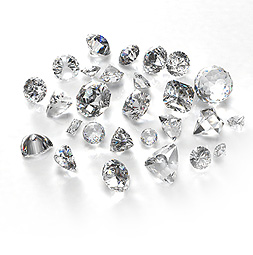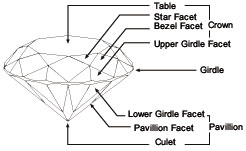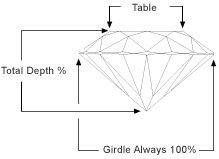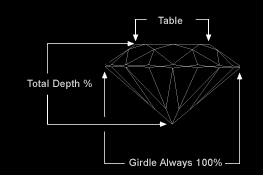
Cut Detail
 The cut of a diamond refers to its proportions. Of the 4C’s, the cut is the aspect most directly influenced by man. The other three are dictated by nature. Cut is very important for diamonds that stand alone in single settings, such as diamond earrings or engagement rings. Canada’s producers earned have a reputation as world-class diamond cutters in recent years.
The cut of a diamond refers to its proportions. Of the 4C’s, the cut is the aspect most directly influenced by man. The other three are dictated by nature. Cut is very important for diamonds that stand alone in single settings, such as diamond earrings or engagement rings. Canada’s producers earned have a reputation as world-class diamond cutters in recent years.
A diamond’s ability to reflect light determines its display of fire and brilliance. Diamonds are usually cut with 58 facets, or separate flat surfaces. These facets follow a mathematical formula and are placed at precise angles in relation to each other. This relationship is designed to maximize the amount of light reflected through the diamond and to increase its beauty.
 Ideal – This range is very strict and combines the best in brilliance and fire. Technically, the head of the class.Excellent – This range is also of great beauty yet slightly more flexible regarding percentages. Many experts prefer the appearance of this range to Ideal.Very Good – This range is balanced between precise proportions and price considerations. Viewed by many as the best overall value in beauty and price.
Ideal – This range is very strict and combines the best in brilliance and fire. Technically, the head of the class.Excellent – This range is also of great beauty yet slightly more flexible regarding percentages. Many experts prefer the appearance of this range to Ideal.Very Good – This range is balanced between precise proportions and price considerations. Viewed by many as the best overall value in beauty and price. 1.1. Well Cut – When a diamond is cut to proper proportions, light is reflected from one facet to another and then dispersed through the top of the stone. Within the Well Cut standards are the EternalDiamonds.com sub categories of Ideal, Excellent, and Very Good.2. Deep Cut – When the cut of a diamond is too deep, some light escapes through the opposite side of the pavilion.3. Shallow Cut- When the cut of a diamond is too shallow, light escapes through the pavilion before it can be reflected.The cut, or proportions, of a diamond is measured in percentages relative to the diameter of its girdle. The girdle diameter of each diamond is always considered 100%. Example: The girdle of a diamond measures 10 millimeters (100%). The table measures 5.6 millimeters. The total depth measurement is 6.1 millimeters. The diamond would be described as having a table of 56% and a depth of 61%. The table and depth percentages are the key to determining good proportions.
1.1. Well Cut – When a diamond is cut to proper proportions, light is reflected from one facet to another and then dispersed through the top of the stone. Within the Well Cut standards are the EternalDiamonds.com sub categories of Ideal, Excellent, and Very Good.2. Deep Cut – When the cut of a diamond is too deep, some light escapes through the opposite side of the pavilion.3. Shallow Cut- When the cut of a diamond is too shallow, light escapes through the pavilion before it can be reflected.The cut, or proportions, of a diamond is measured in percentages relative to the diameter of its girdle. The girdle diameter of each diamond is always considered 100%. Example: The girdle of a diamond measures 10 millimeters (100%). The table measures 5.6 millimeters. The total depth measurement is 6.1 millimeters. The diamond would be described as having a table of 56% and a depth of 61%. The table and depth percentages are the key to determining good proportions.
Princess Radiant
![]() Pear Marquise
Pear Marquise

| Round |  |
 |
|---|---|---|
| Emerald |  |
|
| Oval |  |
 |
| Heart | ||
| Polish |
This characteristic refers to the finishing or final polishing of the facets, or flat surfaces. Contrary to common belief, diamonds are ground and polished, not chipped away, until they reach their final form. Each facet should be carefully fashioned by the diamond cutter to shine and be free from polishing imperfections. The polish of a diamond is generally defined as either Poor, Fair, Good, Very Good, or Excellent. When purchasing a diamond, select one with a polishing grade of Good or above.
Symmetry
This characteristic refers to the alignment and positioning of the facets, or flat surfaces. Each facet should be carefully positioned by the diamond cutter in proper proportion and relationship to the other facets. The alignment of each facet should be sharp and precise; improperly joined facet junctions can make a diamond appear uneven. The symmetry of a diamond is generally defined as either Poor, Fair, Good, Very Good, or Excellent. When purchasing a diamond, select one with a symmetry grade of Good or above.



